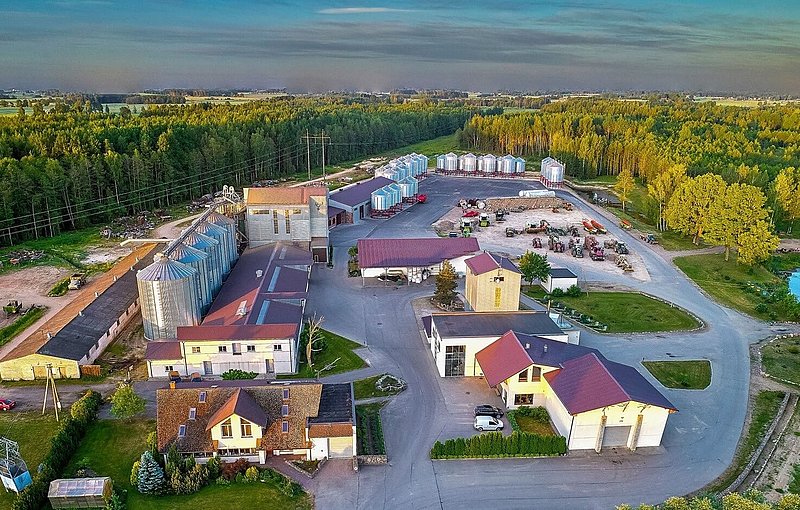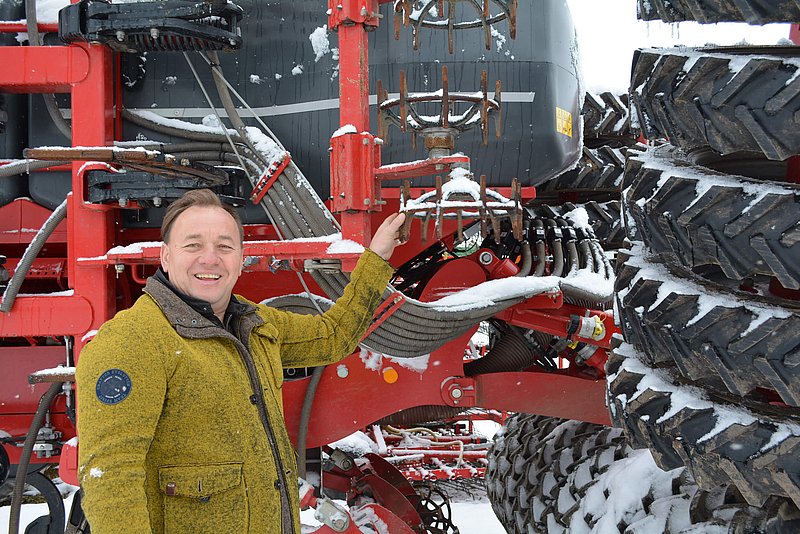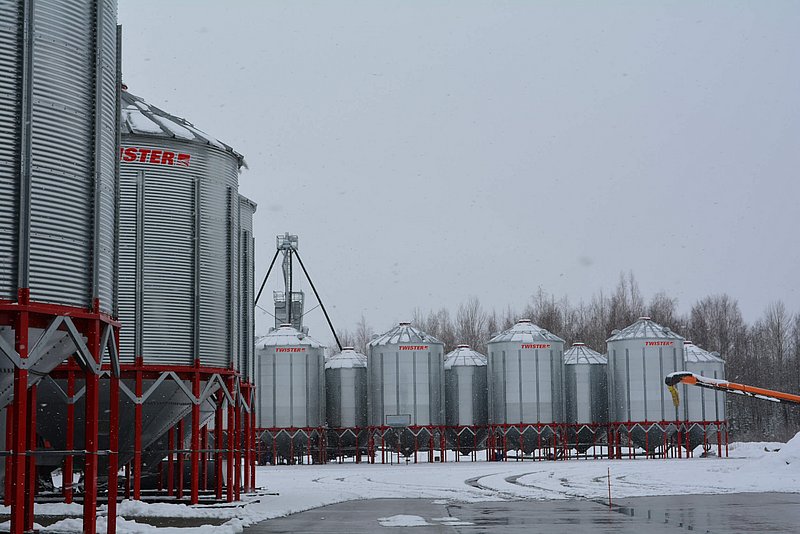
Sowing downwind
Kotini Farm is one of the largest seed producers for cereals and legumes in Latvia. The farm also grows commercial crops. It was set up by the owner Aldis Ločmelis. terraHORSCH visited the farmer shortly before the spring season.
In 1992, Aldis and his father started farming in Viļaka in Sķilbeni Parish (Latgale region) near the Latvian-Russian border. Back then they grew barley on 12 hectares. At the turn of the millennium, they already cultivated 360 hectares, the whole harvest was processed on site. There always was a lot to do, however the income was relatively low. It was time to take a strategic decision. For the farmer it was quite clear: “I will either work with the latest technology or not at all!” Thus, Kotini became one of the largest seed producers in Latvia and every year produces several thousand tons.
Farming
The farm cultivates 3,000 hectares and owns 2,000 of them. The average field size is 22 hectares. Kotini grows a large variety of crops: wheat, barley, oats, rye and rape as well as beans, peas and grass. They sow about 70 % spring crops. “A good rotation is essential. Thus, the need for plant protection agents can be reduced and it allows for working with a technology that does not include a plough and, thus, neither encourages weed seeds nor destroys the biological activity of the soil. Moreover, the windows for sowing and for the harvest are longer so that there are only few work peaks”, Aldis comments on this variety.
They partly sow directly into the stubble – on some fields they have not been using a plough for more than ten years – and they rely on minimum tillage. A shallow cultivation is carried out to loosen the topsoil and to mix in harvest residues. The farmer uses two HORSCH Focus 6 TD and a Cruiser 12 XL. Aldis Ločmelis explains the economic advantages: “When ploughing we need about 16 to 17 litres of diesel per hectare. With the HORSCH StripTill method we only need 11 to 13 litres as we apply fertiliser at the same time and thus, carry out everything in one pass. When you stop using a plough and the rotation is not yet optimum, there might be yield cuts. But don’t give up, it will pay off!“
At first, the farmer preferred the plough or the rotary harrow, simply because he did not have enough experience and the right technology for no-till farming. “Since we stopped using the plough, the structure and the health of our soils have improved. There are more earthworms and more organic matter. Plants with roots do not take up the fertiliser directly. It is processed by soil bacteria and soil fungi. And if the nutrients are not in the soil, the nutrient supply of the plants is insufficient. Deep tillage with a plough or a rotary harrow on the other hand destroys the fine fungus and bacteria net. Moreover, with the no-till system the young plant develops roots at the spot where the previous plant was and where there are still root residues that have already decomposed to additional organic matter. Due to the availability of the nutrients the next harvest will be comfortable, simple and uncomplicated”, Aldis Ločmelis explains.

Wind direction and row spacing
To remain successful, farmers always have to think about different, sometimes not exactly traditional technologies. One of them is the alignment of the seed rows according to the prevailing direction of the wind: “In our region West winds prevail. This is the reason why we sow the rows from East to West so that the wind can enter the soils more easily and dry the excess humidity. Thus, one factor for pathogens is eliminated, especially for closely sown crops. We have to make maximum use of the free resources of nature – sun, water and wind“, Aldis Ločmelis emphasises.
Another special feature of the farm is that crops are sown with a row spacing of 30 cm. The farmer uses a HORSCH Focus – and is more than satisfied. It is already the second year that he sows rape, rye, wheat, triticale, hemp, oats and beans with a 30 cm spacing. “Last year we also tried to sow barley this way. The field looked terrible, but the spikes were well developed. Moreover, threshing lodged grain was easier as, compared to a 15 cm row spacing, it did not lie completely on the ground. For spring barley and flax we still work with a conventional row spacing because it simply fits better“, the farmer says.
Aldis Ločmelis found out that a row spacing of 30 cm is sufficient for driving between the rows without disturbing the plants. Thus, he intends to buy a HORSCH hoeing device for mechanical weed control soon. This technology is ideal for organic farms – and the farmer wants to convert part of his farm to organic farming.

Seed growing
Seed production is Kotini’s core business. “We have been producing seed since the farm has been founded. At the moment we are producing certified seeds on 2,200 hectares. But this line of business is not easy as the demand changes every year. The seeds we grow are as pure as possible and we only use as little plant protection agents as possible”, Aldis Ločmelis says. The farm also disposes of large storage and drying capacities. It produces about 3,000 tons of seeds every year. They dispose of more than 30 silos with a total capacity of almost 7,000 tons.
Products
The farm processes everything that is harvested on the fields. “We only produce food from the things we grow and which we are convinced of. The characteristic of our food is that everything is produced from one certain variety. Thus, we can guarantee the same cooking time and the same taste”, the owner emphasises.
“We constantly analyse the crop varieties because every variety behaves differently”, Aldis Ločmelis explains.
Kotini uses transparent packages for their products so that the customer can see the full quality of the product. They always include recipes and preparation tips.
Kotini also produces mixed fodder for livestock farming – without adding GMO products. The products are sold on the internet and also in health-food shops.
Machinery
On the farm there are eleven tractors, among them two articulated Case tractors with power tracks, four combines, several telehandlers and other machines. The machines the owner is most proud of are in the middle of the farmyard – two HORSCH Focus 6 TD, one with hollow discs for levelling and one with a crumbling roller. Apart from that, the technical equipment is the same. “Since we have been starting to work with HORSCH, we have less machines for tillage. This, of course, reduces the costs“, Aldis Ločmelis states.
The HORSCH seed drills have one main hopper for seed and fertiliser, an optional 400-litre tank can be used to apply a third component. “We sow all crops with these seed drills, beans included. In the past, we ploughed before sowing beans. But since we have been working with the HORSCH machines, we no longer use the plough on these fields“, the farmer is satisfied.
Another important machine is the HORSCH cultivator Cruiser 12 XL which is used to incorporate harvest residues: “The cultivator can work up to a depth of 15 cm. But we do not work deeper than 4 cm. Our normal working depth is 1 to 2 cm. Cultivator, tractor, harrow and sprayer – that’s all we need. We are thinking about buying a hoeing machine to fight weeds mechanically.“
The future
The future development of the farm mainly depends on the expansion of the range of convenience products – and on the production of organic products. “We want to certify part of our farm for organic farming, e.g. no longer use plant protection agents for beans and introduce an organic product line. We are planning vegetarian and vegan product lines. There also will be gluten-free products which are particularly important for a lot of people. We want to supply people with what they want – eating in a simpler and cheaper way“, Aldis Ločmelis summarises his farming philosophy.